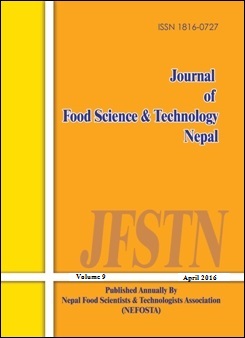A simple HPLC Method for the Determination of Caffeine Content in Tea and Coffee
DOI:
https://doi.org/10.3126/jfstn.v9i0.16200Keywords:
Extraction, Caffeine, HPLC, Method validationAbstract
A simple HPLC-UV method was developed and validated for the determination of Caffeine content in tea and coffee samples of different local brands commercially available at Kathmandu and Kaski, Nepal. Water extracted caffeine was separated through c-18 column (ODS 5 μm, internal diameter 4.6 nm and length 150 mm) using methanol and water (40:60) as a mobile phase. The peak response time for caffeine was observed at 2.66 minutes using UV detector set at 275 nm. Method validation parameters viz. linearity, sensitivity (LOD & LOQ), repeatability and recovery were assessed for the detection of caffeine. Linear dynamic range was 2-10μg/ml with correlation coeffi cient (R2) of 0.9928. The LOQ and LOD were found to be 0.7 and 0.2μg/ml respectively. Relative standard deviation for retention time for intraday repeatability was 0.9 and for inter-day 1.63%. Recovery was measured by spiking blank tea samples and the results of recovery were greater than 97%. The validated method was fi nally adapted to determinate caffeine content in Nepalese tea and coffee samples. The average caffeine contents in tea and coffee were found in the range of (2.5-3.53) % and (1.17-1.34) % on dry basis respectively.
Downloads
Downloads
Published
How to Cite
Issue
Section
License
The author will be the copyright holder of this open access journal - 'Journal of Food Science and Technology Nepal (JFSTN)'.




